Spring houses keep your food cold without power by tapping into nature's own refrigeration system. You'll find these structures built near natural springs, where water maintains a steady 50°F year-round – about 10°F cooler in summer and 7°F warmer in winter than surface water. The combination of flowing spring water, thick stone walls, and underground placement creates perfect cooling conditions. As spring water circulates through channels in the building, it cools the air while the stone construction and earth provide natural insulation. There's much more to discover about these ingenious structures that have kept food fresh for centuries.
Ancient Cooling Through Natural Springs
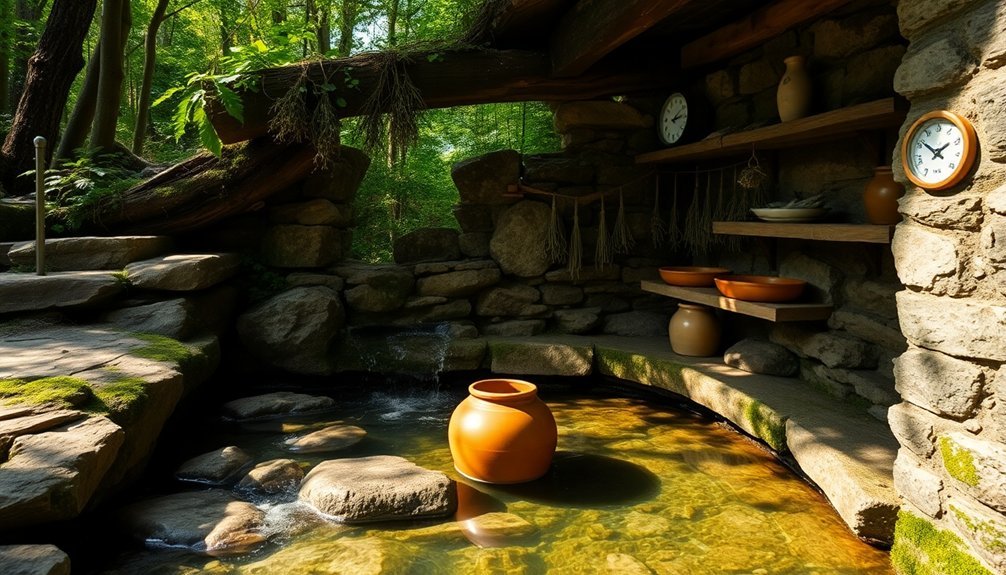
Many ancient civilizations discovered that spring water provided a remarkably consistent natural cooling system. They noticed that spring water maintained steady temperatures year-round, staying cooler than surface water in summer and warmer in winter.
Similar to underground dwelling networks in ancient Turkey, these natural spring systems provided stable cooling. You'll find that springs typically run about 9.7°F cooler than streams during hot months and 7.0°F warmer during cold months.
The Navajo Indians exemplified this understanding by channeling spring water into trenches, where evaporation would cool the surrounding air. This natural process didn't just lower temperatures; it also added beneficial humidity to dry environments.
You can see similar principles at work in traditional springhouses, where the combination of cold spring water and evaporative cooling creates an effective preservation environment.
When you examine ancient cooling methods, you'll notice they're built around trapping and utilizing these natural temperature differences. They'd dig out the springhouse floor to collect the cool water and construct the building to maximize the spring's cooling effects.
Location and Building Materials Matter
When setting up a spring house, success hinges on two essential factors: location and building materials.
You'll need to build directly over a natural cold spring where water flows up from underground, maintaining a steady temperature of around 50 degrees Fahrenheit. This underground water source creates a consistently cool environment that's naturally protected from external heat.
The building materials you choose play a vital role in maintaining these cool temperatures. You'll want to use materials with strong insulating properties, typically stone and wood, to create an enclosed environment that prevents warm air from entering. This cooling method helps maintain temperatures below 40 degrees Fahrenheit, which is essential for storing perishable foods safely.
Inside, you'll need to construct water channels or pools where you can place pottery and containers either directly in the cool water or nearby to benefit from the ambient temperature.
While you're designing the structure, don't forget to incorporate natural ventilation features that enhance the cooling effect without compromising the internal temperature.
The combination of proper location over a natural spring and thoughtful use of insulating materials creates an effective passive cooling system that'll keep your food preserved without requiring any power source.
How Spring Water Creates Coolness
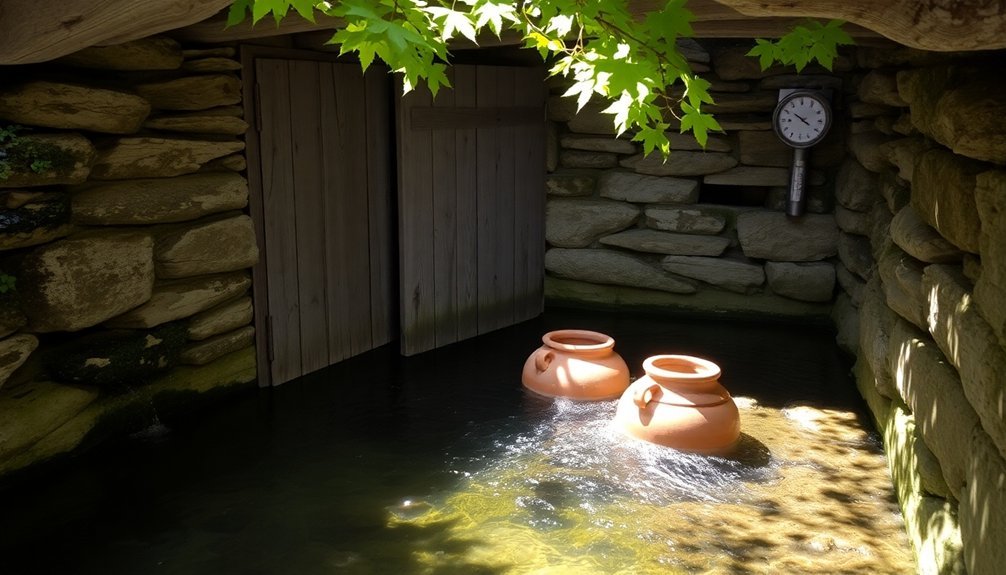
You'll find that spring water naturally maintains a consistent temperature of around 50°F (10°C) year-round due to its underground source being insulated from surface temperature changes.
When you channel this water through a spring house, you're taking advantage of water's high heat capacity to create a cooling effect that spreads throughout the structure.
The constant flow of cool spring water helps maintain this stable temperature, making it perfect for preserving food without electricity. This natural cooling process is highly effective, as demonstrated by Spring Creek's average of 52.3°F which keeps temperatures well below the stress point for sensitive items.
Natural Underground Temperature Control
Throughout history, spring houses have harnessed the remarkable stability of underground temperatures to create natural cooling systems. You'll find that about 20 feet below the surface, the earth maintains a constant temperature between 50-60°F year-round, regardless of seasonal changes above ground. This natural phenomenon creates the perfect foundation for food preservation without the need for power.
| Underground Feature | Cooling Effect |
|---|---|
| Ground Temperature | Maintains 50-60°F at 20ft depth |
| Spring Water | Emerges at constant 50°F |
| Insulated Structure | Prevents external heat infiltration |
| Preservation Method | Keeps food cold year-round |
When you explore a spring house, you'll notice how the emerging spring water, typically around 50°F, works in harmony with the ground's natural temperature. The structure's design cleverly encloses the spring and creates an insulated environment that maintains these cool temperatures. You don't need electricity or ice – the natural underground cooling system does all the work. This efficient method has proven its worth through centuries of use, keeping perishables like meat, dairy, and fruits fresh before modern refrigeration existed.
Constant Water Flow Benefits
Three key mechanisms make spring water flow incredibly effective for cooling in spring houses.
First, you'll find that spring water maintains a consistent temperature of around 50 degrees Fahrenheit throughout the year, creating a reliable cooling environment for your food storage needs. This natural temperature control doesn't fluctuate with seasonal changes, guaranteeing your perishables stay consistently cool.
Second, the continuous flow of water maximizes cooling efficiency. When you place milk jugs or crocks directly in the water channel, the constant movement of cool water around these containers creates an effective heat exchange system. This flowing water continuously carries away warmth from your stored items, maintaining their cool temperature without any power input.
Third, you'll benefit from the spring's natural pressure system, which keeps water moving without any mechanical intervention. This constant circulation prevents stagnation and guarantees even cooling throughout the storage area.
You won't need pumps or electricity to maintain this flow, making it an efficient, cost-effective solution for food preservation. The steady water movement also helps distribute the cool temperature uniformly throughout your spring house, creating a reliable preservation environment.
Underground Temperature Stays Constant
The remarkable stability of underground temperatures makes spring houses effective for year-round food storage. You'll find that once you go below 2.5 meters underground, temperatures become considerably more stable and less affected by what's happening at the surface.
By the time you reach 5-6 meters deep, you're dealing with fundamentally constant temperatures throughout the year.
What's particularly interesting is how this stability works. The ground's temperature variations decrease exponentially as you go deeper, and by 10 meters, you'll consistently find temperatures around 9°C year-round.
The soil's water content plays an essential role here – higher moisture levels improve thermal conductivity and heat capacity, which helps maintain this stability. You won't see the daily temperature swings that occur above ground, as these only affect the top meter of soil.
There's also a time lag effect to take into account. When you're at spring house depth (typically 5-6 meters), temperature changes at the surface take about six months to reach this level, which helps maintain consistent cooling conditions for your stored food throughout the year.
Stone Walls and Natural Insulation
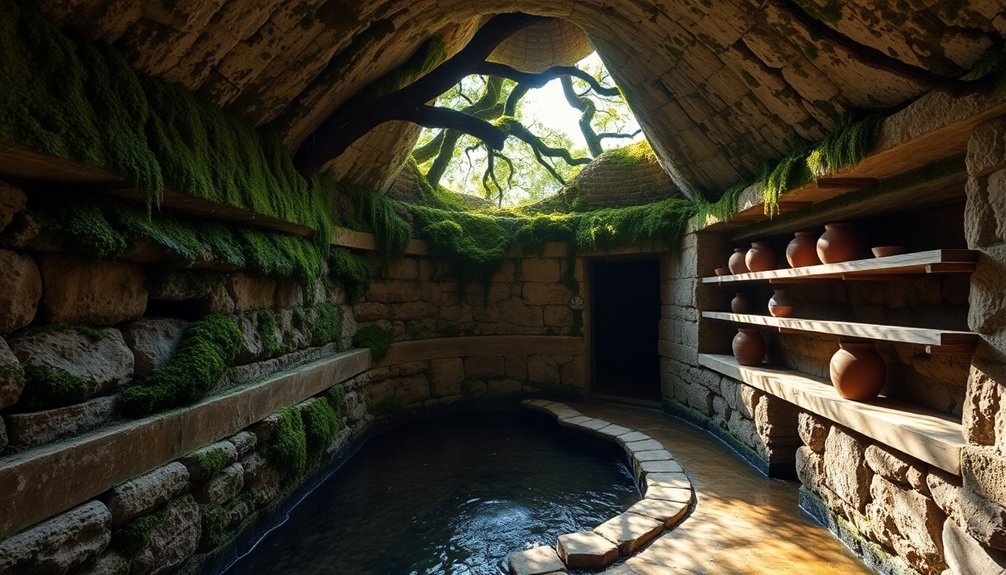
Spring houses' stone walls serve a dual purpose in food preservation, combining thermal mass properties with natural insulation techniques. The thick stone walls, typically 1-2 feet wide, absorb heat during warmer periods and release it when temperatures drop, helping maintain a steady internal temperature.
You'll find that these walls work best when they're part of the building's insulated envelope, creating an efficient system for temperature regulation.
The natural insulating properties of spring houses are enhanced by several key design elements:
- Stone walls absorb the constant underground temperature, acting as a buffer against external temperature fluctuations
- The thickness of the walls provides substantial thermal mass, slowing heat transfer
- Natural moisture barriers form within the dense stone structure
- Cool spring water running through the building adds another layer of temperature control
- The combination of stone and water creates a naturally humid environment ideal for food preservation
While stone walls aren't great insulators on their own, their thermal mass properties, when combined with the building's design and natural water features, create an effective passive cooling system.
This is why spring houses can maintain consistently cool temperatures without requiring any power source.
Food Storage Methods Inside
Inside these well-insulated stone structures, efficient food storage methods maximize the natural cooling properties of spring houses. You'll find milk-filled pails hanging from rafters, while stoneware crocks line the shelves, filled with pickled vegetables and fermented goods. The internal temperature, consistently maintained in the mid-50°F range, creates ideal conditions for preserving perishables.
You can store large joints of meat on hooks, keeping them fresh for extended periods. The cool water from the spring flows through channels around the structure, helping maintain the stable temperature year-round.
When you're organizing your storage space, you'll want to arrange items to maximize ventilation and accessibility. To guarantee food safety, you'll need to check and rotate stored items regularly.
The damp, cool environment works particularly well for dairy products, fruits, and vegetables, while protecting them from pests and direct sunlight. You'll find that stoneware crocks are especially effective for storing pickled items and corned meats.
Spring House Design Features
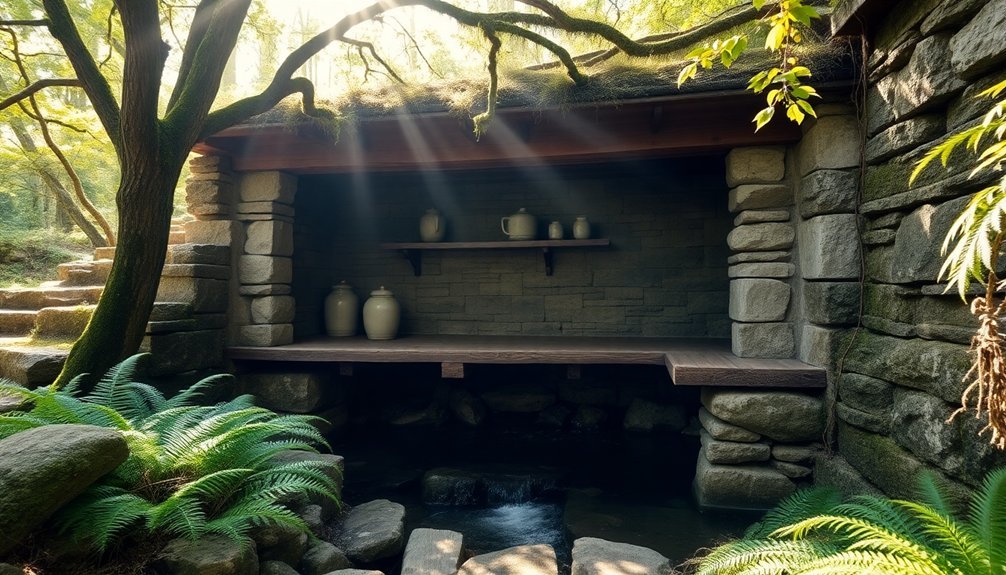
You'll find the fundamental design of a spring house relies heavily on sturdy stone wall construction that withstands years of water exposure while maintaining structural integrity.
Natural underground insulation works in harmony with the stone walls, keeping temperatures consistently cool by utilizing the earth's natural thermal properties.
The strategic water channel layout guarantees proper water flow through the structure, directing the spring water efficiently to create ideal cooling conditions for food storage while preventing stagnation.
Sturdy Stone Wall Construction
When building a spring house, sturdy stone walls serve as the foundation for successful food preservation.
You'll need to start with a proper foundation by digging below the frost line and verifying it rests on bedrock or solid subsoil. The ground must be level and clear of all vegetation, with careful consideration given to preventing water accumulation around the structure.
For the walls themselves, you can choose either mortared or mortarless construction, but the key is maintaining adequate thickness to guarantee temperature stability. Stone and concrete blocks provide excellent thermal mass, helping to capture and maintain cold temperatures throughout the structure.
Here's what makes stone walls particularly effective for spring houses:
- Natural water resistance prevents rot and deterioration
- High thermal mass properties maintain consistent cold temperatures
- Superior durability compared to other building materials
- Local fieldstone availability reduces construction costs
- Excellent flood resistance when properly constructed
You'll need to maintain your stone walls through regular inspections and prompt repairs of any damage.
With proper construction and maintenance, your spring house's stone walls will provide reliable food preservation capabilities for generations, withstanding harsh weather conditions while maintaining consistent interior temperatures.
Natural Underground Insulation
Natural underground insulation plays an essential role in maintaining the efficiency of a spring house. When you build a spring house against a hillside, you're taking advantage of the earth's natural insulating properties to regulate internal temperatures. The soil surrounding the structure acts as a barrier, keeping the interior cooler during summer months and providing warmth during winter.
You'll find that the strategic placement of spring houses maximizes these insulating benefits. By positioning the structure near or directly over a natural spring, you're creating a cooling system that works in harmony with the underground elements.
The building is often partially sunken into the ground, which enhances the insulation effect and helps maintain the constant 50°F temperature that's ideal for food preservation.
The combination of hillside construction and natural spring water creates a remarkably efficient cooling environment without any need for artificial refrigeration. When you store your perishables inside, they benefit from both the cool spring water temperature and the earth's insulating properties.
This dual cooling effect guarantees your food stays fresh longer, making the spring house a reliable food preservation system that doesn't require power.
Strategic Water Channel Layout
A spring house's water channel layout serves as its operational cornerstone, directing the flow of cold spring water to maximize its cooling potential. You'll find that spring water emerges at a consistent 50°F year-round, making it perfect for natural refrigeration. The water's collected in a well or basin before flowing through carefully designed channels that minimize contamination risks.
The strategic layout includes these essential features:
- Central collection pipes made of cast iron or PVC that gather and direct spring water
- Gravel filtration systems that protect and clean the water flow
- Storage areas with crocks and jugs placed directly in the water channel
- Multiple distribution pipes that split the flow for different cooling needs
- Overflow pipes and sediment filters to maintain ideal water quality
You'll need to maintain the channels regularly to guarantee their efficiency. The system's designed with durable materials like concrete blocks or stone, while geotextiles and pond liners prevent contamination.
When properly maintained, this strategic layout creates a reliable cold storage system that keeps your food fresh without requiring any power, making it an efficient and sustainable solution for food preservation.
Maintaining Year Round Cold Temperatures
Through ingenious design principles, spring houses maintain remarkably consistent cold temperatures year-round. You'll find that these structures achieve their cooling effect by tapping into natural spring water, which stays at a steady temperature throughout the seasons, typically in the mid-50°F range.
The stone construction and hillside placement work together to insulate the interior from external heat sources. You won't need to worry about temperature fluctuations because the continuous flow of spring water helps maintain stability.
The structure's small size maximizes the cooling efficiency, while the stone walls prevent heat transfer from the outside environment. When you build into a hillside, you're taking advantage of the earth's natural insulating properties, which further stabilizes the internal temperature.
The design doesn't rely on any power source – it's completely sustainable. You'll notice that even during the hottest summer days, the spring house remains cool enough to preserve dairy products, meats, and fruits.
The combination of flowing water, stone construction, and earth insulation creates an environment that's consistently cold enough for food preservation, regardless of the season or weather conditions outside.
Historic Farm Preservation Techniques
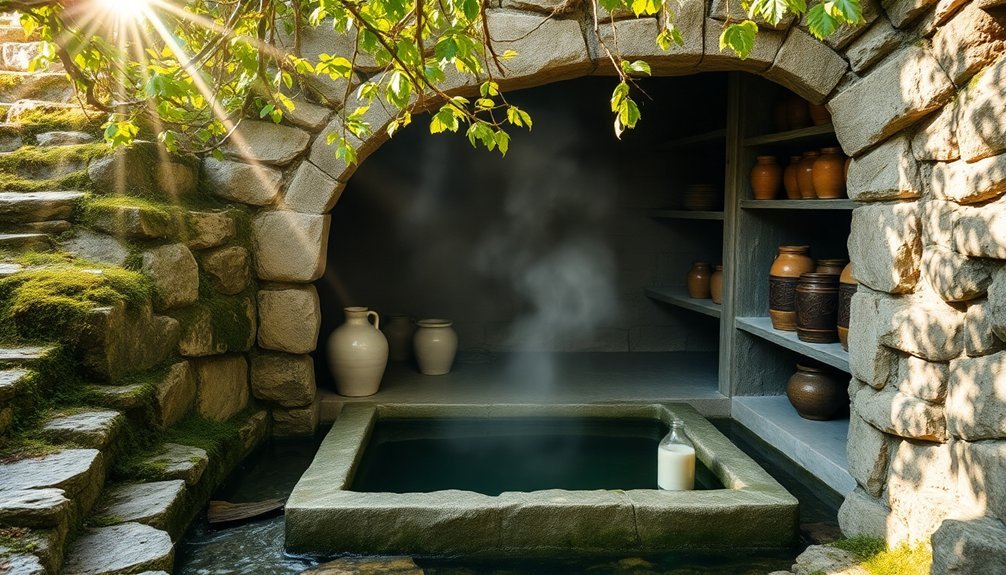
Preserving historic farm structures requires a systematic approach to documentation, protection, and rehabilitation. Before you begin any preservation work, it's crucial to understand the structure's historical significance and document its role in the agricultural heritage of the area.
You'll need to assess the building's current condition and identify specific threats that could compromise its integrity.
To successfully preserve historic farm structures, consider implementing these key strategies:
- Conduct thorough surveys to document the building's architectural features and historical significance
- Research and record the property's history to establish its importance in local agricultural development
- Seek historic designation to access preservation incentives and protective measures
- Engage the community through educational events and media coverage
- Implement regular maintenance plans to prevent deterioration
When you're working to preserve historic structures, you'll want to balance maintaining authenticity with practical considerations.
Remember that successful preservation often involves finding new uses for old buildings while respecting their original character.
You can help protect these valuable pieces of agricultural heritage by promoting public awareness and securing financial support through grants and community partnerships.
Spring Houses Versus Modern Refrigeration
While historic farm buildings tell stories of agricultural heritage, the shift from spring houses to modern refrigeration marks one of farming's most significant technological leaps.
When you compare these two preservation methods, you'll find distinct differences in their operation and effectiveness.
Spring houses maintained a constant temperature of around 50°F using natural spring water, which limited their cooling capabilities. You couldn't adjust the temperature to accommodate different food types, and you'd need to rely on the spring's natural flow to keep items cool.
In contrast, your modern refrigerator offers precise temperature control and can cool foods much faster using electric or gas-powered systems.
You'll notice that spring houses required considerable effort to maintain. You'd need to clean them regularly and ascertain proper water flow, while modern refrigerators demand minimal maintenance.
Though spring houses served their purpose well until the mid-20th century, they couldn't match the convenience and versatility of modern refrigeration.
Today's refrigerators let you store more food varieties in larger quantities, and you don't have to worry about natural water sources or seasonal variations affecting your food preservation capabilities.
Building Into Hillsides
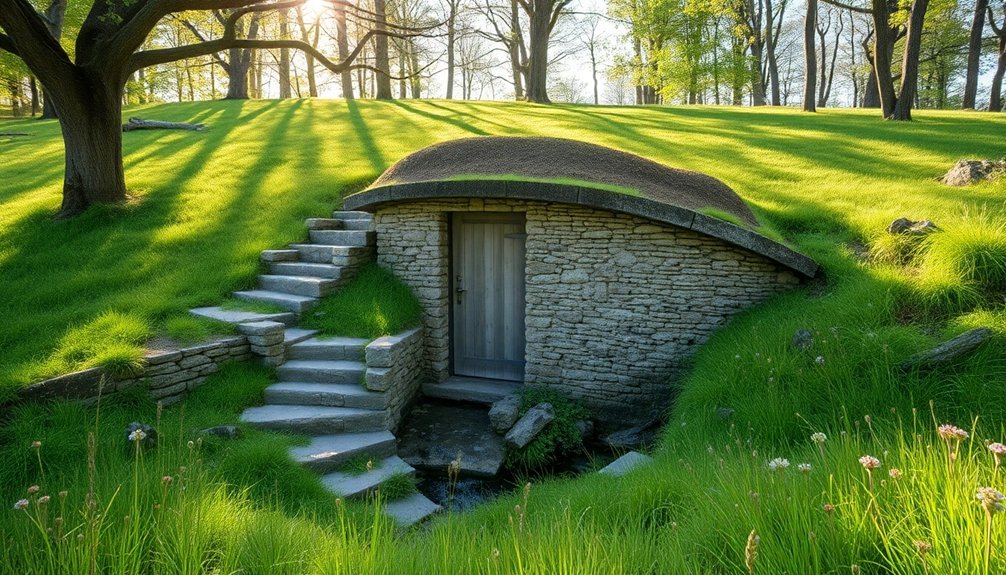
Building a spring house into a hillside required careful planning and architectural finesse to work with the natural landscape.
You'll want to design your spring house to become part of the hill rather than dominating it, following the principle of being "of the hill, not on the hill." This approach helps minimize excavation while maintaining natural water flow patterns.
When constructing a spring house into a hillside, you'll need to take into account these critical elements:
- Install proper vapor barriers and drainage systems to prevent dampness and flooding in the semi-submerged structure
- Use dark exterior materials, like wood, to help the structure blend with its surroundings
- Incorporate retaining walls to ground the building and connect it with the land
- Plan for seasonal changes that can affect the structure's appearance and functionality
- Include terraced walkways and landscaping to merge the built environment with nature
You'll also need to focus on practical construction aspects, such as creating temporary access roads and staging areas.
Don't forget to replant disturbed areas after construction to restore the natural landscape.
Working with local landscape architects can help guarantee your spring house integrates seamlessly with the hillside while maintaining its food preservation functionality.
Water Flow and Cooling Channels
When you study natural spring movement patterns in a spring house, you'll notice that water naturally flows up from underground at a constant cool temperature around 50 degrees Fahrenheit.
You can direct this natural flow through engineered channels or pipes, which lets you control the water's path and create cooling pools where needed.
The carefully planned channels, often lined with gravel to improve flow and cleanliness, maximize the water's cooling potential while preventing stagnation and maintaining water purity.
Natural Spring Movement Patterns
Natural springs follow predictable movement patterns as groundwater travels through underground spaces between rocks, eventually finding its way to the surface.
You'll find that this water movement resembles how liquid moves through a sponge, with gravity and pressure working together to guide the flow downward and sideways through the earth.
When the water emerges, it creates distinct patterns that make spring houses effective for food preservation:
- Springs can flow continuously at rates around 5.5 gallons per minute, providing a reliable cooling source
- The water maintains a consistent temperature (typically around 50°F) year-round due to earth's insulation
- You'll notice the water collects in basins or channels before flowing outward to streams or pipes
- Some springs flow steadily while others are intermittent, depending on rainfall and water table levels
- The emerging water can range from a gentle trickle to a strong continuous flow
Understanding these movement patterns helps you harness the spring's cooling power effectively.
The consistent flow and temperature create ideal conditions for food storage, while the natural channeling of water makes it easy to direct the flow where it's needed most in your spring house.
Engineering Water Channel Design
Designing efficient water channels forms the backbone of any successful spring house cooling system. You'll need to carefully consider channel placement, sizing, and flow patterns to maximize cooling effectiveness. The channels should maintain consistent water flow while ensuring ideal heat transfer from stored food items to the cooling water.
| Design Element | Key Consideration |
|---|---|
| Channel Distance | Keep channels within 1D of cooling area |
| Channel Diameter | Use 3/8" to 1/2" for ideal flow |
| Flow Pattern | Maintain turbulent flow regime |
To enhance your spring house's cooling efficiency, you'll want to incorporate wire coil inserts in the channels. These inserts can boost heat transfer coefficients by 1.4 to 2 times, depending on your water flow rate. The pitch of the wire coil matters more than its diameter, so focus on optimizing the spacing between coils.
Your channel design should promote symmetrical cooling patterns, ensuring food items receive uniform temperature distribution. Consider using high-conductivity materials for channel construction, as they'll improve heat transfer rates. If you're dealing with complex cooling requirements, you might want to implement a micro-channel system, which can maintain surface temperatures closer to the water's natural temperature.
Sustainable Food Storage Solutions
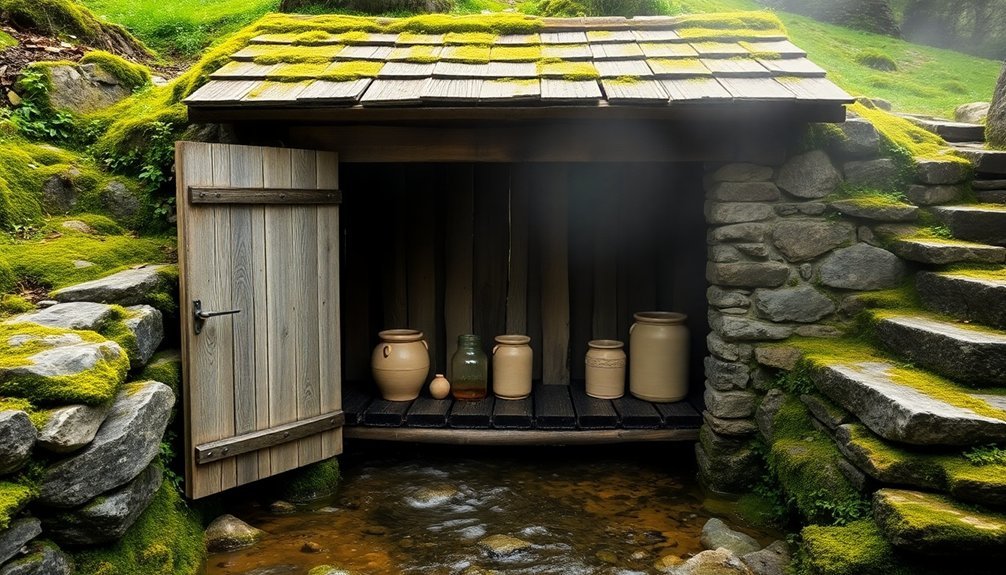
Modern sustainable food storage combines eco-friendly materials with efficient design to reduce environmental impact while preserving food effectively.
You'll find that today's storage solutions utilize materials like glass, stainless steel, and bamboo, which offer durability while eliminating harmful chemicals. These materials work together with passive cooling systems that can lower temperatures by up to 19°F from ambient conditions without using power.
For ideal food preservation, you'll want to take into account these key sustainable storage solutions:
- Use BPA-free Tritan Copolyester containers with removable silicone gaskets for airtight storage
- Install cooling pads between 0.01-0.2m thick to maximize passive cooling efficiency
- Store produce in temperatures between 32-60°F, depending on the specific item
- Select storage locations like basements or root cellars for consistent cool temperatures
- Maintain proper ventilation to control humidity levels
When implementing these solutions, you'll need to regularly clean your storage containers and check for temperature consistency.
Frequently Asked Questions
How Long Could Meat Safely Be Stored in a Spring House?
You can safely store fresh meat in a spring house for 5-7 days, as the cool temperatures (around 50°F) slow spoilage. Cured and smoked meats last even longer when kept in these conditions.
Could Spring Houses Be Used in Regions Without Natural Springs?
Yes, you can build a spring house without natural springs. You'll need to divert water from creeks, build channels, or use dug-out cellars with running water to achieve the same cooling effect.
What Happened to Spring Houses During Severe Droughts?
During severe droughts, you'll notice your spring house's cooling ability weakens as water flow decreases. You'll face structural damage from soil shrinkage, and you'll need to find alternative food preservation methods due to reduced effectiveness.
Did Native Americans Use Similar Structures Before European Settlers Arrived?
Yes, you'll find Native Americans used natural cooling features like lava tubes and caves as refrigerators. They'd store bison meat and other perishables in these naturally cold spaces long before European settlers arrived.
How Did Families Determine the Ideal Spring Location for Construction?
You'd look for a reliable spring on elevated ground near your home, testing water flow and soil stability. You want consistent year-round water, good drainage, and natural hillside protection for insulation.
In Summary
You'll find that spring houses offer an ingenious, eco-friendly way to keep food cool without electricity. By tapping into natural spring water and utilizing the earth's constant underground temperature, you're harnessing the same principles that kept food fresh for generations. Whether you're looking to reduce your carbon footprint or prepare for power outages, these time-tested structures prove that sometimes the old ways work best.

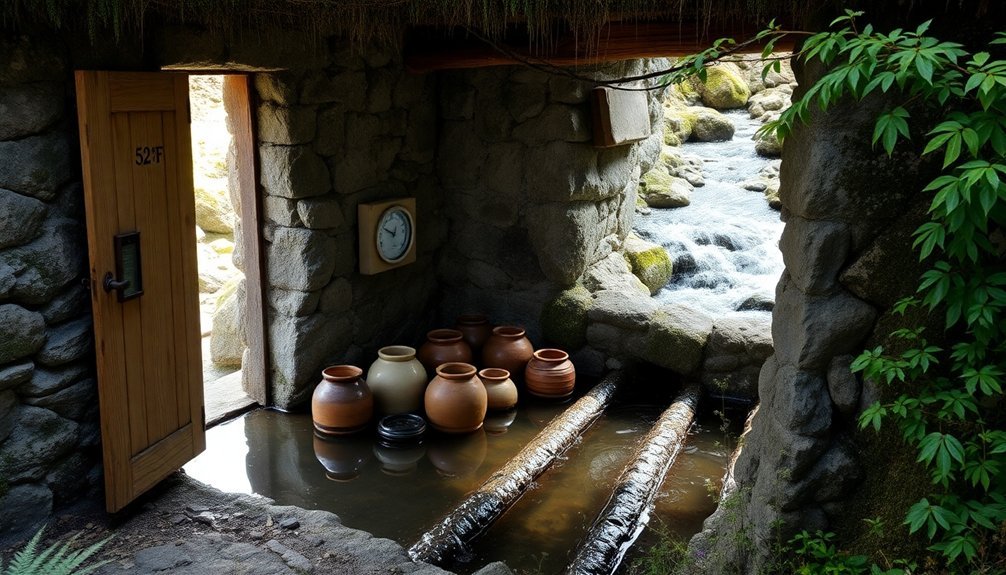



Leave a Reply